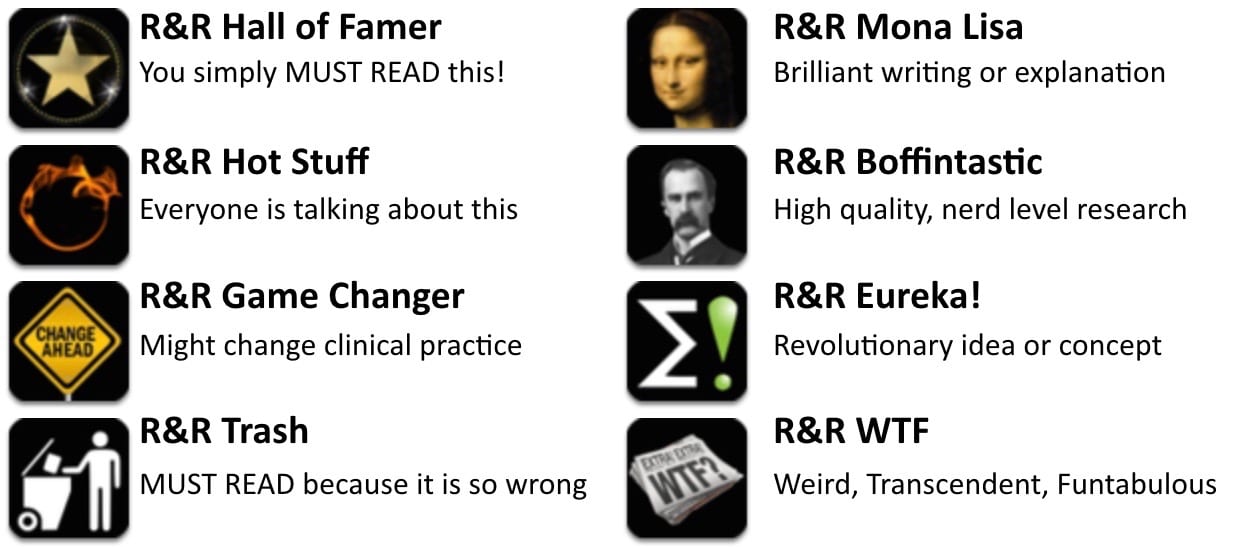R&R In The FASTLANE 154
Welcome to the 154th edition of Research and Reviews in the Fastlane. R&R in the Fastlane is a free resource that harnesses the power of social media to allow some of the best and brightest emergency medicine and critical care clinicians from all over the world tell us what they think is worth reading from the published literature.
This edition contains 5 recommended reads. The R&R Editorial Team includes Jeremy Fried, Nudrat Rashid, Soren Rudolph, Anand Swaminathan and, of course, Chris Nickson. Find more R&R in the Fastlane reviews in the : Overview; Archives and Contributors
This Edition’s R&R Hall of Famer
Rietveld S et al. Rollercoaster asthma: when positive emotional stress interferes with dyspnea perception. Behaviour research and therapy. 2007. PMID 16989773
- I love this paper, but I am not sure why. I think it has just been too long since I was last on a rollercoaster. This study explored the relationship between perceived dyspnea (subjective) and objective lung function based on emotional stress. Prior research has shown that negative stress or emotions are associated with an increased sensation of dyspnea despite unchanged objective respiratory values. The authors wondered whether the opposite – positive stress, or joyful situations – would decrease the sensation of dyspnea. They provoked this sensation by having women with severe asthma ride rollercoasters. (They prescreened the women to ensure that they all liked rollercoasters.) Immediately after the ride, at a time of positive stress, perceived dyspnea was significantly lower, despite FEV1 measurements that were actually a little lower than baseline. In other words, positive emotions seem to decrease the sensation of dyspnea.
Bottom line: Dyspnea is a complex phenomenon. Although I don’t have a rollercoaster in my department, an awareness of the impacts of emotion on dyspnea could help us improve patient comfort. - Recommended by Justin Morgenstern
Piazza G et al. A Prospective, Single-Arm, Multicenter Trial of Ultrasound-Facilitated, Catheter-Directed, Low-Dose Fibrinolysis for Acute Massive and Submassive Pulmonary Embolism The SEATTLE II Study. JACC Cardiovasc Interv 2015. PMID 26315743
- Catheter directed thrombolytics in massive/submassive PE physiologically makes sense as it should increase clot breakdown and reduce bleeding events, particularly ICH (historically ~ 3% w/ systemic lytics). This single arm study showed a 0% ICH rate in 150 patients while decreasing RV/LV diameter ratio. While this is a surrogate endpoint and not a patient centered one, this is a promising step in figuring out the best approach to managing these patients.
- Recommended by Anand Swaminathan
Courtney DM, et al. Clinical features from the history and physical examination that predict the presence or absence of pulmonary embolism in symptomatic emergency department patients: results of a prospective, multicenter study. Ann Emerg Med. 2010. PMID 20045580
- One of the great salami slices from the PERC dataset; here they report the different odds ratios for each factor they analyzed. Most impressive? None of the ORs are over 3. The most positive made it into PERC. Some interesting factors that turned out not to relate to PE: smoking, pregnant, sudden onset of symptoms, inactive cancer, or fever.
- Recommended by Seth Trueger
Gaeta F et al. Tolerability of aztreonam and carbapenems in patients with IgE-mediated hypersensitivity to penicillins. J Allergy Clin Immunol. 2015. PMID 25457154
- True penicillin allergy can potentially limit antibiotic options as many antibiotics from cephalosporins to carbapenems to aztreonam have reported cross-reactivity. A number of publications have shown low cross-reactivity (1-3%) between penicillins and cephalosporins as well as low cross-reactivity between penicillins and imipenem/meropenem (~ 1%). This study, using skin tests, found that 0 out of 211 patients demonstrated cross-reactivity between penicillin and aztreonam. The authors recommend skin testing prior to administration and skin testing isn’t a perfect surrogate for a systemic reaction upon IV administration but the best evidence we have shows that cross-reactivity is highly unlikely.
- Recommended by Anand Swaminathan
Levi M. Management of bleeding in patients treated with direct oral anticoagulants. Crit Care. 2016. PMID 27543264
- A limitation of direct-acting oral anticoagulants (DOACs) is the absence of an strategy to rapidly reverse the effect in bleeding patients and patient undegoing invasive procedures.In this well written review the author presents a short overview of incidence and risk factors of bleeding while on DOACs and VKAs and a strategy for reversal of the anti-factor Xa agents (rivaroxaban, apixaban, and edoxaban) and the direct thrombin inhibitor dabigatran using specific and nonspecific measures.Nonspecific measures are prothrombin complex concentrate (Octaplex) 50 U/kg, activated prothrombin complex concentrate (FIEBER) 50 U/kg and recombinant factor VIIa (NovoSeven). The doses of PCC and aPCC are different from our national Danish recommendations of 25 U/kg.Specific reversal may be achieved with andexanet, a new agent currently in development that competitively binds to the anti-factor Xa agents (rivaroxaban, apixaban, and edoxaban) and the Fab fragment of a monoclonal antibody (idarucizumab) for dabigatran.Furthermore here’s a nice lecture on reversal of anticoagulants in ICH. Many principals may be extrapolated to other patients https://vimeo.com/181133240
- Recommended by Soren Rudolph
Senior Consultant Anesthesiologist, Traumemanager and PHEM doctor. Dedicated to trauma resuscitation, prehospital care and airway management. Barometerbarn | @SorenRudolph |







